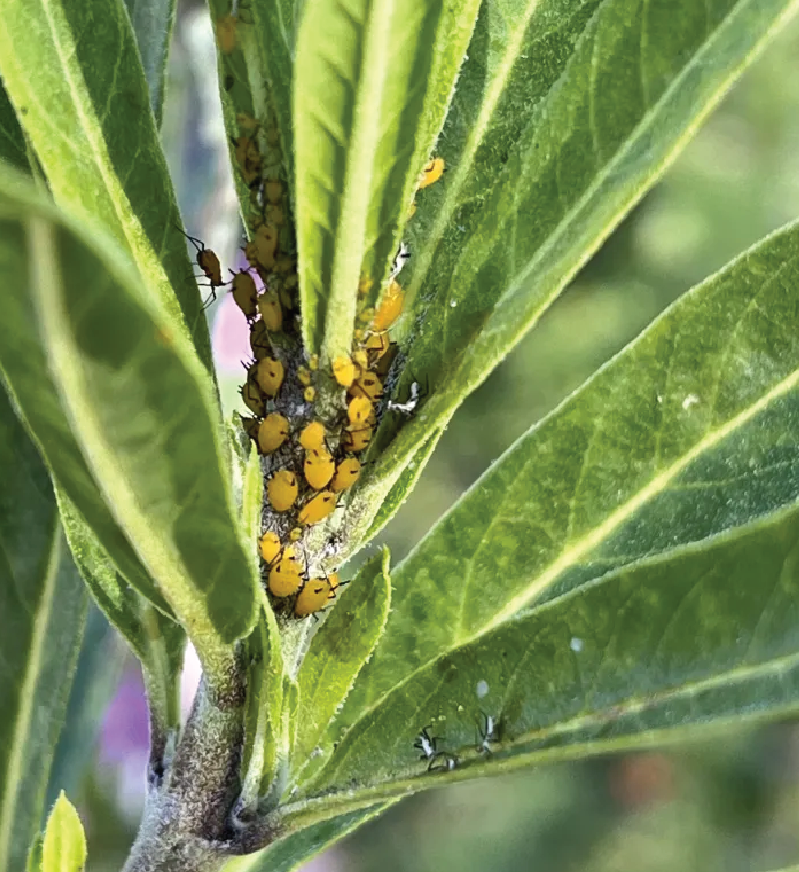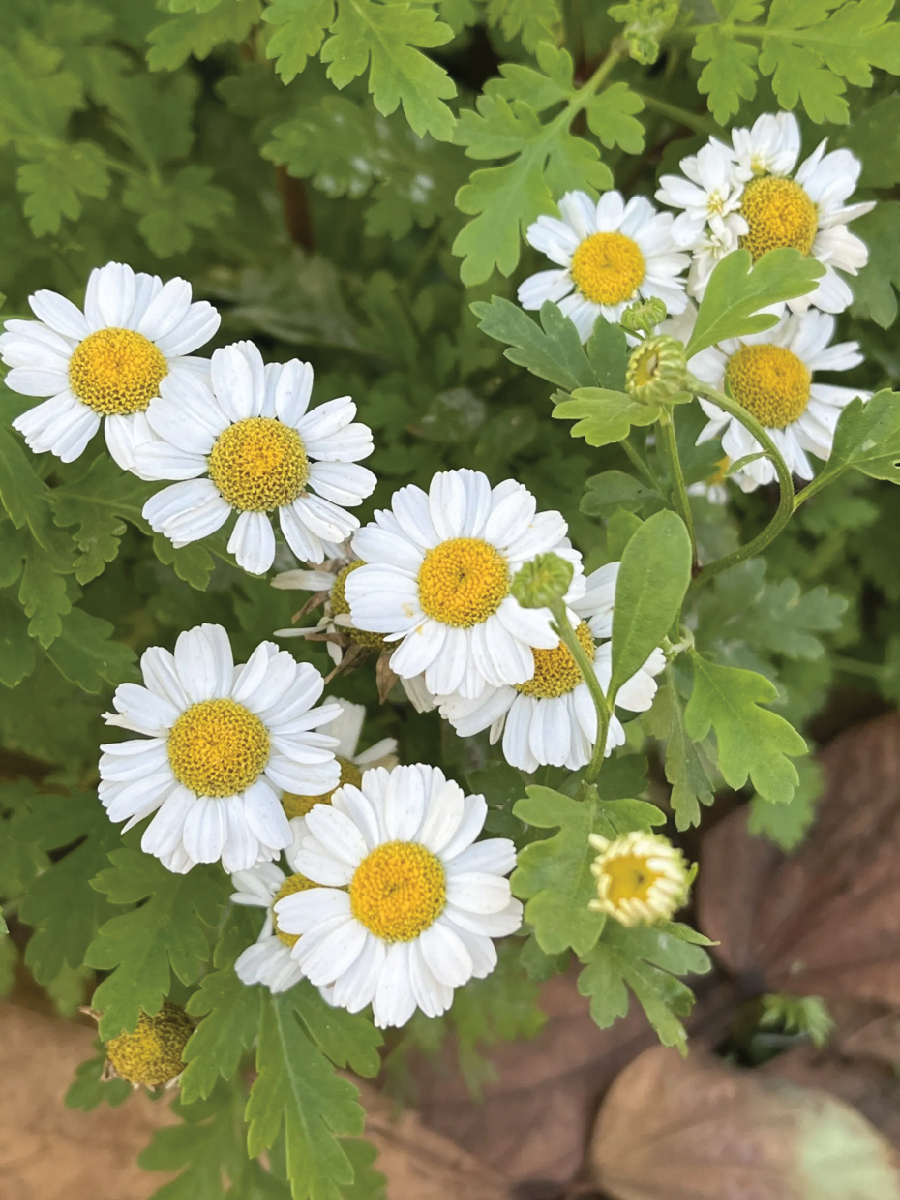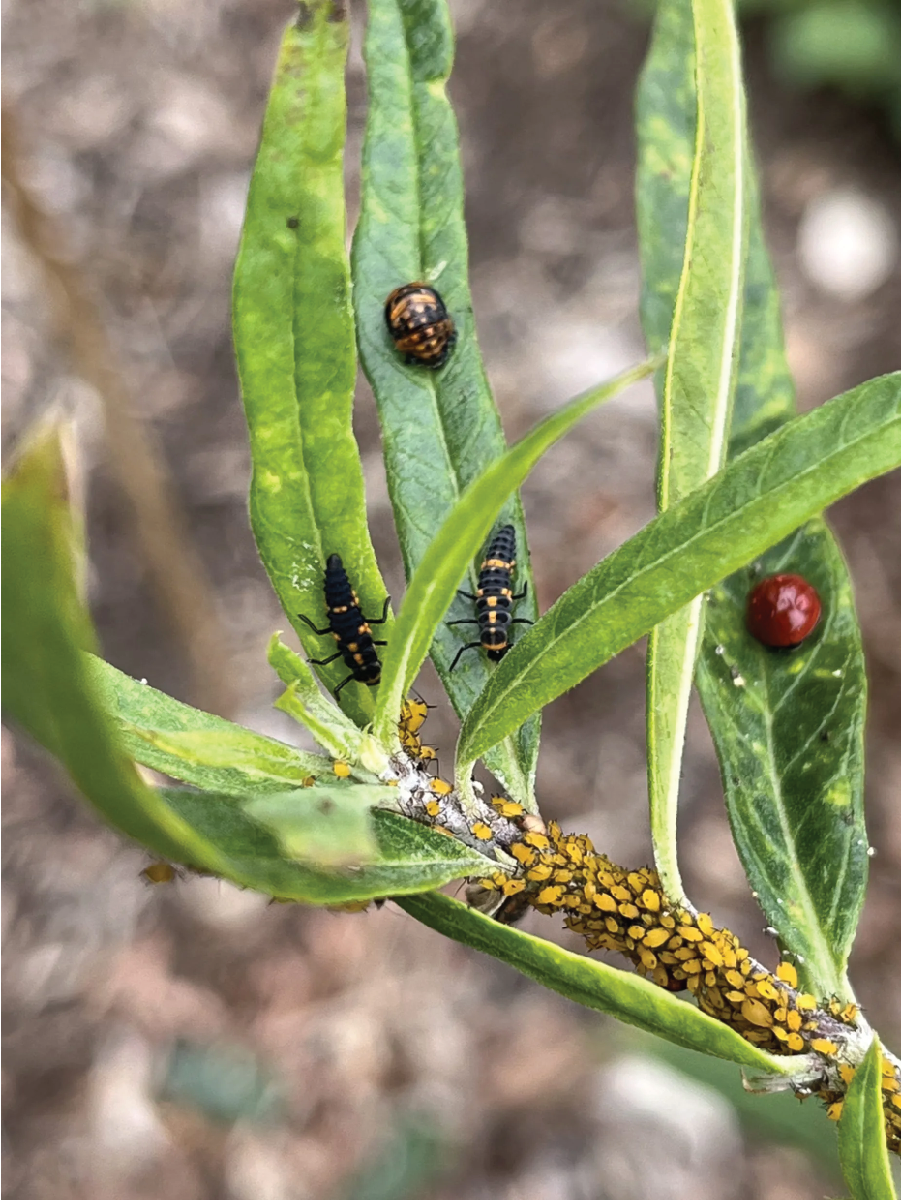Look for natural antidotes to aphids in your plantings

Aphids usually feed in dense groups on the leaves or stems of plants. (Susan Pransky)
By Susan Pransky
(This article was originally in the May 10, 2025 issue of the San Diego Union/Tribune)
Does it ever seem that you look at one of the plants in your garden and it’s totally fine, and then the next time you look at it, it’s covered with aphids? That could be because aphid populations can grow surprisingly quickly, with one adult producing up to 80 offspring in a week!
But wait — that does not mean it’s time to grab a bottle of insecticide. Most established plants can tolerate aphids feeding on their leaves and will outgrow any damage.
Natural enemies, which are also known as “beneficial insects,” can be very helpful for controlling aphids. However, spraying with broad spectrum pesticides such as organophosphates, carbamates and pyrethroids kills the natural enemies. Natural enemies usually don’t appear in large numbers until the aphid population gets larger, so you might need to be patient. Another benefit of being patient is that some aphids do not tolerate heat and will be gone with the arrival of hot weather. In the meantime, the first line of defense can be to knock off or hose off the aphids, or prune them out.
Aphids are tiny — only 1/8-inch long at most. They have soft bodies with long legs and antennae. They also have two of a unique feature called “cornicles,” which are tail pipes at the end of the abdomen. They generally do not have wings, but when they get too crowded or the host plant quality declines, they produce winged forms that move to new plant hosts. They don’t fly very well but can travel for miles with the wind because they’re so small.
Aphids are usually seen feeding in dense groups on the leaves or stem of plants, although they can be found individually. Most aphids don’t move very quickly, even when disturbed. Aphids can be green, yellow, brown, red or black.

Growing feverfew (shown), sweet alyssum, marigolds and yarrow can help attract ladybugs and other beneficial insects to your garden. (Susan Pransky)
Ants are often an early sign of the presence of aphids on a plant because they protect aphids from their natural enemies. Dealing with ant infestations can help reduce the aphid population by making it easier for beneficial insects to get to the aphids. Ant stakes or containerized bait can control ants without harming beneficial insects.
Aphids can produce a lot of “honeydew,” which is a sticky substance that often turns black with the growth of sooty mold. On established trees such as citrus, both the aphids and the honeydew they produce can be a valuable food source for beneficial insects.
Aphids are the favorite food of ladybug larvae. Very few people know what ladybug larvae look like, so there is a photo here showing the stages of a ladybug’s life. Other natural enemies of aphids include adult ladybugs, lacewings, syrphid fly larvae, soldier beetles and tiny parasitic wasps. Various species of parasitic wasps lay their eggs inside aphids, which turn the aphids into crusty brown “mummies.” Once you begin to see mummies on your plants, you’ll likely see a substantial reduction in the number of aphids within a week or two. On the UC integrated pest management (IPM) web page, there is a “Natural Enemies Gallery” (ipm.ucanr.edu/natural-enemies) where you can look at pictures of the predators that eat garden pests, to help you avoid inadvertently killing them.
If all else fails and insecticides seem necessary, use products that are less toxic to natural enemies, such as insecticidal oils and soaps. These products should not be applied to drought-stressed plants or when it is very hot. Some plants are sensitive to these products.

These two alligatorlike ladybug larvae are closing in on their favorite food: aphids. (Susan Pransky)
Aphids can spread viruses among some vegetable and ornamental plants, including cucumber, bean, potato, squash, pumpkin, melon, lettuce, beet, chard and bok choy. Check your plants for aphids several times a week to help catch them before the infestations get too big.
In addition to eating pests like aphids, ladybugs eat pollen in various types of garden plants. Grow the following plants to help attract beneficial insects, and specifically ladybugs, to your garden: butterfly weed, calendula, coreopsis (tickseed), cosmos, feverfew, marigolds, Queen Anne’s lace, statice, sweet alyssum and yarrow. Letting flowers form on cilantro, chives, dill and/or parsley also attracts ladybugs to your garden.
The other day I wanted to show a friend the milkweed plant covered with aphids shown in the photo accompanying this article. The aphids were gone! I had seen a ladybug the previous week, but I certainly didn’t expect the aphids to be completely eradicated. Doesn’t nature sometimes seem impossibly beautiful? Let nature do its magic in your garden.
Pransky has gardened in San Diego for more than 30 years and has been a Master Gardener since 2012.

